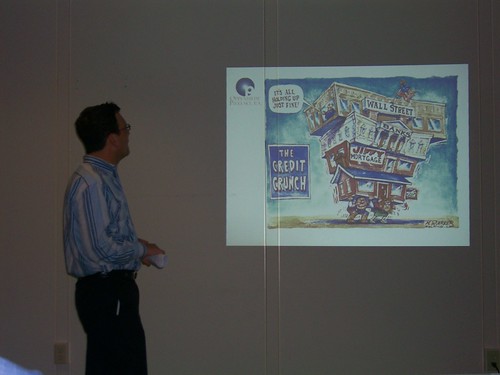I met James Montier at a value investment seminar in Italy in 2007 where he presented. We had long discussions later the day and into the evening on value investing and investment strategy.
James was kind enough to put me on his distribution list and I really looked forward to each of his articles as they always taught me something.
Unfortunately James decreased his writings since taking a position with the asset manager GMO in 2010.
I decided to put this resource page together so Eurosharelab visitors can also benefit from James’s investment wisdom.
James Montier’s Amazon Page shows all the books he has authored as well as the following short biography:
James Montier is a member of GMO’s asset allocation team.
Prior to that, he was the co-Head of Global Strategy at Société Générale and has been the top-rated strategist in the annual Thomson Extel survey for most of the last decade.
Montier is the author of four market-leading books:
• The Little Book of Behavioral Investing: How not to be your own worst enemy (Little Book, Big Profits)
• Behavioral Finance: Insights into Irrational Minds and Markets
• Behavioral Investing: A Practitioners Guide to Applying Behavioral Finance
• Value Investing: Tools and Techniques for Intelligent Investment
He is a Visiting Fellow at the University of Durham and a Fellow of the Royal Society of Arts.
2010
In this May 2010 article called I Want to Break Free, or, Strategic Asset Allocation does not equal Static Asset Allocation James Montier talks about in the beginning investing was a simpler and happier.
The essence of investment was to seek out value; to buy what was cheap with a margin of safety. Investors could move up and down the capital structure (from bonds to equities) as they saw fit. If nothing fit the criteria for investing, then cash was the default option.
But that changed with the rise of modern portfolio theory and, not coincidentally, the rise of “professional investment managers” and consultants.
In March 2010 Miguel Barbosa in his Simolean Sense blog interviewed James Montier about his book Value Investing: Tools & Techniques For Intelligent Investing.
In the second part of the interview Miguel talks to James about his other book The Little Book of Behavioral Investing – How Not To Be Your Own Worst Enemy.
In this February 2010 article, the first since joining GMO, James Montier asks Was It All Just A Bad Dream? Or, Ten Lessons Not Learnt from the financial crisis.
2009
In November 2009 article titled Only White Swans on the Road to Revulsion James Montier makes the argument that that the housing bubble and the crisis following its collapse was not an unforeseen event but rather the result of over optimism and the illusion of control, two classic human behavioural mistakes.
This article is the text of a speech called Six Impossible Things Before Breakfast, or how EMH has damaged our industry which James Montier delivered at the at the August 2009 CFA UK conference on “What ever happened to EMH”. Dedicated to Peter Bernstein (EMH = Efficient Market Hypothesis)
Here is the video recording of the above mentioned speech by James Montier: Six Impossible Things Before Breakfast. The video is 42 minutes long, but well worth watching.
The financial times in this 24 June 2009 article EMH, AMH: Edwards and Montier ride again motions James Montier leaving Societe Generale to join US investment manager Grantham Mayo Van Otterloo & Co, just after he and Albert Edwards won the Thomson Extel European analysts award in May 2009 as the top global strategy team.
In this 2 June 2009 research paper Forever blowing bubbles: moral hazard and melt-up James Montier explored the bubble phenomenon and what happens in the future after a bubble pops. He explores the possibility that all the government rescue packages initiated in 2008 have the possibility to again inflate a substantial bubble.
In this 24 June 2009 Financial Times article called Insight: Efficient markets theory is dead. James Montier explains why the efficient markets theory is dead but still lives because of academic inertia.
In June 2009 James Montier’s published this list of his Favorite Investment Books as well as a Summer reading list of more recent titles.
In May 2009 shortly after the market started its recovery from its March 9 2009 lows James Montier in this article titled Sucker’s rally or the birth of a bull? asks if this is a suckers rally and if so what investors could do to protect themselves. He also gives a few short ideas from his shorting screen.
In this 27 January 2009 article Clear and present danger: the trinity of risk, James Montier writes about the three primary and interrelated sources of investment risk; Valuation risk, business or earnings risk and balance sheet or financial risk.
2008
In this excellent review of James Montier’s book – Behavioral Investing: A Practitioner’s Guide to Applying Behavioral Finance, Bruce Grantier summarises the main points of the book with emphasis on mistakes and biases followed by a discussion of number of behavioral phenomena.
In the article The psychology of bear markets published in December 2009, during the brunt of the bear market James Montier writes about that the mental barriers to effective decision-making in bear markets are as many and varied as those that plague rationality during bull markets but that they more pronounced as fear and shock limits logical analysis.
In this 25 Nov 2008 article called The road to revulsion and the creation of value, James Montier argues that the road to revulsion – sharply declining prices – ends in an investment nirvana with unambiguously cheap assets.
In this 25 November 2008 Bloomberg article Montier Has ‘Never Been More Bullish’ on Stocks James Montier makes the cast that stocks are “distinctly cheap” because they trade at 15.4 times the 10-year moving average of its companies’ profits, compared with an average of 18 for the U.S. market since 1881.James wrote that fifteen stocks in the U.S. index, pass his test for “deep value,” while a tenth of shares in Europe and a fifth in Asia qualify.
In this 27 October 2008 article – An admission of ignorance: a humble approach to investing James Montier details his investment strategy.
It makes no sense to forecast, the importance of a margin of safety, avoid trying to time the market and buy cheap insurance. But most importantly, humility should be the central theme of a good investment process.
In this October 22nd, 2008 Financial Times blog post by Paul Murphy summarises an article Analysts are rubbish by James Montier about the bullish bias built in to the investment industry by the analysts and that analysts are exceptionally good at one thing and one thing only – telling you what has just happened.
In this 9 September 2008 article – The dangers of DCF James Montier writes about the dangers Of Discount cash flow (DCF) saying its implementation is riddled with problems but the good news is that several alternatives exist.
In this 23 June 2008 article – You are still wasting your time, or, are analysts just overpaid secretaries? James Montier writes about the whether company visits are useful for fund managers. The answer in general is no but they can be improved by learning to look for evidence that disagrees with us, and seek to disprove our ideas, rather than illustrate them with supportive evidence.
In this article The Road To Revulsion 16 June 2008 James Montier writes about bubbles, that bubbles are a by-product of human behaviour, and that human behaviour is sadly all too predictable.
The details of each bubble are different but the general patterns remain very similar. He also touches on the propensity for commentators to continually proclaim the end of the problem and a resumption of business as usual.
In the 30 May 2008 article Inflation Not The Problem Albert Edwards and James Montier explain why they are sceptical of all the market commentators saying that the worse market decline of the recession was over. How right they were, but it’s the way they arrived at their conclusion that makes the article worthwhile reading.
If you have any interest at all in short selling this is an article for you. On 26 May 2008, with the markets particularly overvalued James Montier turned his thinking to short selling writing Joining The Dark Side: Pirates, Spies and Short Sellers.
In the article he explains a simple short screen with surprising results shown through back testing in the USA and Europe.
In the article with the catchy title Asleep at the wheel, or, How I learned to stop worrying and love the bomb published on 7 April 2008 James Montier points out that company management and analysts are unwilling to revise their profit estimates in spite of the looming recession as everyone thinks their business is recession resistant. He points out that this is why they are all overoptimistic and how you can avoid falling into the same trap.
In this 13 March 2008 research article called Remember, Cassandra was right! James Montier makes a strong argument that the mess in the US economy and housing market was not caused by a black swan event (unpredictable) but rather was sadly predictable.
It follows the standard pattern of a bubble deflating, some thing that we have seen a thousand times before.
On 12 January 2008 James made the last post on his blog called Behavioural Investing – The application of psychology to finance and the home of an investing sceptic.
The articles he wrote is luckily all still there and it’s a real treasure trove of information.
In this 15 January 2008 article The Dash To Trash And The Grab For Growth James Montier wrote just shortly after the absolute peak in the 2008 bull market he suggests that if you cannot move to cash because of career risk then invest in large dividend paying companies as what is going to happen to growth stocks at already high valuations is not going to be pretty. How right he was.
2007
In this blog post called The Sources of Value, written in October 2007 James Montier analyses which of the component sources of return leads to value, over reasonable periods of time, to outperform growth?
On 3 October 2007 James Montier posted a blog article titled Sector rotation: an investment dead end? He argues that investors focusing on sectors rather than stocks are barking up the wrong tree.
James Montier’s book Behavioural investing: a practitioner’s guide to applying behavioural finance was published in September 2007. At the link above you can read parts of the book at Google Books.
In this 24 September 2007 blog post called The myth of exogenous risk and the recent quant problems James Montier argues that many aspect of investment risk are endogenous (like a gambler playing poker, where the actions of the other plays are integral to the game) to the way in which we invest.
The problems experienced by the quant funds in August may help highlight some of these issues.
In this 10 September 2007 blog post Yet more evidence on the folly of forecasting, or why we don’t need economists! James Montier presents even more evidence that humans cannot forecast and why you should avoid listening to anyone who says he can as well as avoid it yourself.
On 21 August 2007 James Montier posted a blog article titled Earnings manipulation as a source of short ideas. He identifies shorting candidates through a measurement called the M score. Past results are impressive in identifying under-performing companies.
On 15 March 2007 James Montier posted a Macro Research article titled Global Equity Strategy . Investing 101: A reading list. Here he comes up with a collection of his best books in different categories (classics, modern, psychological and hidden gems) that is arguably the best reading list for any aspiring investor.
In the 30 January 2007 article by James Montier CAPM is CRAP James says that the capital asset pricing model (CAPM) is insidious. It creeps into almost every discussion on finance. And them he goes on to systematically take the model apart with real life examples and evidence.
In his 10 January 2007 research paper Contrarian or conformist? James Montier, in his usual style puts himself against the common view saying that the then biggest consensus portfolio bets to him seemed to be small cap and low quality however large cap, high quality looks like the better bet to him. To emphasise he quotes Sir John Templeton once observed, “It is impossible to produce a superior performance unless you do something different from the majority”.
2006
In this 30 November 2006 article with the enticing title Improving returns using inside information James Montier explains the results of a unknown but interesting research paper on share buybacks and how they, when implemented, are a powerful indicator for positive returns.
In this July 2006 research note titled Come out of the closet, or, show me the alpha James features a study that suggests
closet indexing accounts for nearly one third of the US mutual fund industry. Stock pickers account for less than 30% of the market, yet they have real investment skill. A fascinating read.
The article Prophet Among Pinstripes in the April 2006 issue of Fastcompany magazine features James Montier where he gives his five laws about investing bias, evolution, and true happiness.
In March 2006 shortly after the release of Joel Greenblatt’s book The Little Book That Beats the Market James tested the strategy worldwide and in this article called The little note that beats the markets found that on average the Little Book strategy
beats the markets by around 7% p.a. between 1993-2005, and with lower risk than the market! Value plus quality seems to make sense.
In the article Behaving Badly published in February 2006 James Montier features a short test you can take after which you will also become a strong believer in behavioural finance. Give it a try!
2005
In November 2005 James Montier wrote the article Seven Sins of Fund Management – A behavioural critique where he explores some of the more obvious behavioural weaknesses inherent in the ‘average’ investment process.
For example he writes that the first sin was placing forecasting at the very heart of the investment process. An enormous amount of evidence suggests that investors are generally hopeless at forecasting. So using forecasts as an integral part of the investment process is like tying one hand behind your back before you start.
In this 31 March 2005 article called Bargain Hunter James Montier confesses that he is an unabashed value investor. He adds that if the reader does not share this viewpoint, or isn’t open to be persuaded of the merits of such an approach, he should stop reading now for what follows will only distress his.
James teams up with Rui Antunes his “usual accomplice and compatriot in adventures involving large amounts of data” and embarked upon an investigation of value strategies.
In the article Abu Ghraib: Lessons from behavioural finance and for corporate governance, wrote at the end of January 2005 James Montier says even though it is tempting to believe bad behaviour is the result of a few rotten individuals. However, the overwhelming psychological evidence suggests that if you put good people into bad situations they usually turn bad.
2004
In the June 2004 paper If it makes you happy James Montier leaves investment advice aside and explores one of Adam Smith’s obsessions: what it means to be happy.
He also discusses why that’s important to investors, and how we can seek to improve our own levels of happiness. The article further lists
James’s top ten suggestions for improving happiness.
In the article Who’s a Pretty Boy Then? Or Beauty Contests, Rationality and Greater Fools James Montier in February 2004 played a classic Keynes’ beauty contest with over 1000 professional investors.
He found that on average professional investors are using between one and two steps of strategic thinking in forming their expectations. He also found that many investors suffer the curse of knowledge and end up either picking zero or severely underestimating the irrationality of other players.
These results speak directly to the ability of investors to exit the market before the mass exodus. He found, unsurprisingly, that only a very small minority shows the required level of strategic thinking to beat the gun.
In this 76 page presentation Insights into irrational minds and market Applied Behavioural Finance: Insights into irrational minds and market James Montier gave in 2004 he in great detail described the behavioural biases investors are prone to. Its a great summary of a lot of his previous work in a presentation format, summarised in bullet points and graphs.
2003
This November 2003 issue of welling@weeden James Montier offers a reality and earnings checks.
In this January 2003 research paper Running with the Devil: The Advent of A Cynical Bubble James Montier explores the nature and underlying psychology of four different kinds of bubbles. To assess which comes closest to describing the current market.
To us, the current market environment is largely a greater fool market. Because such markets lack fundamental support, they are liable to precipitous declines.
2002
In Darwin’s Mind: The Evolutionary Foundations of Heuristics and Biases James Montier in December 2002 writes that a catalogue of biases that cognitive psychologists have built up over the last three decades seem to have stem from one of three roots – self-deception, heuristic simplification (including affect), and social interaction.
In this paper James explores the evolutionary basis of each of these roots. The simple truth is that we aren’t adapted to face the world as it is today. We evolved in a very different environment, and it is that ancestral evolutionary environment that governs the way in which we think and feel.
In 22 November 2002 James Montier wrote in Part man, part monkey that leaving the trees could have been our first mistake. Our minds are suited for solving problems related to our survival, rather than being optimised for investment decisions. We all make mistakes when we make decisions. The list below gives a top ten list for avoiding the most common investment mental pitfalls.
- You know less than you think you do
- Be less certain in your views, aim for timid forecasts and bold choices
- Don’t get hung up on one technique, tool, approach or view flexibility and pragmatism are the order of the day
- Listen to those who don’t agree with you
- You didn’t know it all along, you just think you did
- Forget relative valuation, forget market price, work out what the stock is worth (use reverse DCFs)
- Don’t take information at face value, think carefully about how it was presented to you
- Don’t confuse good firms with good investments, or good earnings growth with good returns
- Vivid, easy to recall events are less likely than you think they are, subtle causes are underestimated
- Sell your losers and ride your winners
>
I recently reviewed Gary Rivlin's important new book, Broke USA, for the Huffington Post. Thus, I was stunned when I noticed that the book had been reviewed by the Wall Street Journal.
I wondered if the reviewer, Katherine Mangu-Ward, and I had read the same book.
f you go by her philosophy, payday lenders and other members of the "poverty industry" are upstanding entrepreneurs, performing a service for society!
She waits until the second to last paragraph to "mention" that payday lenders are providing this wonderful service at "something like a 300% to 400% interest rate."
Ms. Mangu-Ward makes a historic comparison of those in the "poverty industry" with loan sharks of a different era. I'm not sure that Mangu-Ward, a Yale University graduate, has ever met a loan shark. I have.
As I note in my book Son of a Son of a Gambler, loan sharks and gamblers populated my hometowns of Covington and Newport in Northern Kentucky.
Although the sharks were aggressive in their collections policies, any loan shark who charged 400% would have soon been floating in the Ohio River.
I also doubt that many loan sharks were ever touted for their entrepreneurial acumen in the Wall Street Journal.
The sad thing is that the Wall Street Journal would allow such a slanted and biased reviewer to write a review for their newspaper.
She leaps to conclusions that show a lack of research, especially for a graduate of an Ivy League school.
For example, she said that Rivlin brings "a level of financial illiteracy and disdain for entrepreneurs that is somewhat surprising in a man who once covered Silicon Valley for the New York Times."
If Mangu-Ward had done her homework, she would have read Rivlin's books, The Plot to Get Bill Gates and The Godfather of Silicon Valley. The first book shows Rivlin's tremendous empathy with the featured entrepreneur and the second shows some keen insights into how businesses truly operate.
Anyway, Broke USA is not about entrepreneurism. It's about the poverty industry and how loan sharking has become legalized.
Rivlin devotes much of his book to efforts in North Carolina and other states to offer payday loans at a more reasonable interest rate. He notes how the United States armed services put a 36% cap on any payday loans made to military personnel.
None of that important information made it into a "review" that in the author's mind puts payday lenders in the same category as Mother Teresa: Doing good for the poor.
I don't remember Mother Teresa charging 400% interest rates.
Despite what the Wall Street Journal says, Broke USA is an even-handed look at the poverty industry.
A little even-handedness would have gone a long way in the Wall Street Journal's review.
http://online.wsj.com/article/SB10001424052748704629804575325840351124892.html?mod=googlenews_wsj
http://www.huffingtonpost.com/don-mcnay/wall-street-and-legalized_b_596986.html
Don McNay, CLU, ChFC, MSFS, CSSC is an award-winning financial columnist and Huffington Post Contributor.
You can read more about Don at www.donmcnay.com
McNay has Master's Degrees from Vanderbilt and the American College and is in the Hall of Distinguished Alumni of Eastern Kentucky University.
McNay has written two books. Most recent is Son of a Son of a Gambler: Winners, Losers and What to Do When You Win The Lottery
McNay is a lifetime member of the Million Dollar Round Table and has four professional designations in the financial services field.
penis enlargementHitting a wall of bipartisan opposition to placing a price on carbon, even if just in the utility.
Shep Smith laid into his own network Wednesday, calling out Fox News for its role in hyping the Shirley Sherrod story based on an edited videotape (h/t Mediaite). Smith's critique began when he cut into Wednesday's briefing by White ...
While President Obama may be trying to avoid diving into the racial fray right now, Rachel Maddow jumped right in last night. In a fairly devastating segment Maddow tied this week's Shirley Sherrod debacle to previous cases, ...

internet marketing courseHitting a wall of bipartisan opposition to placing a price on carbon, even if just in the utility.
Shep Smith laid into his own network Wednesday, calling out Fox News for its role in hyping the Shirley Sherrod story based on an edited videotape (h/t Mediaite). Smith's critique began when he cut into Wednesday's briefing by White ...
While President Obama may be trying to avoid diving into the racial fray right now, Rachel Maddow jumped right in last night. In a fairly devastating segment Maddow tied this week's Shirley Sherrod debacle to previous cases, ...
big white booty




